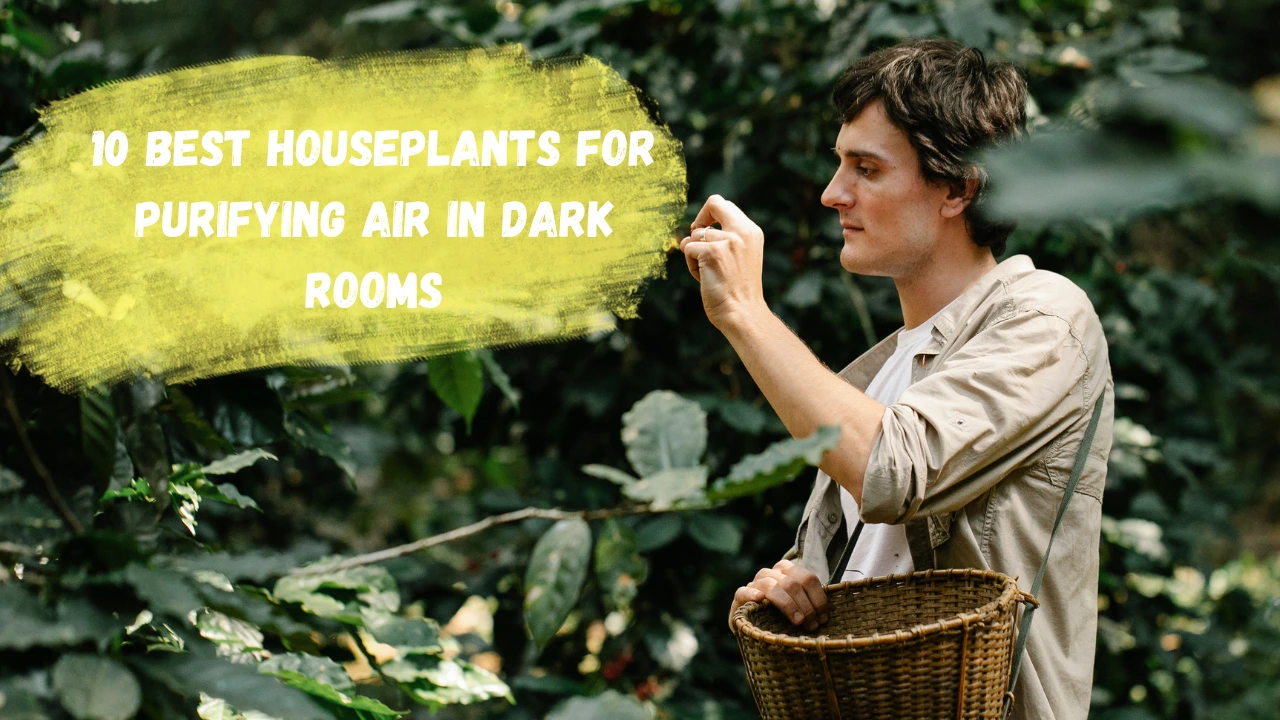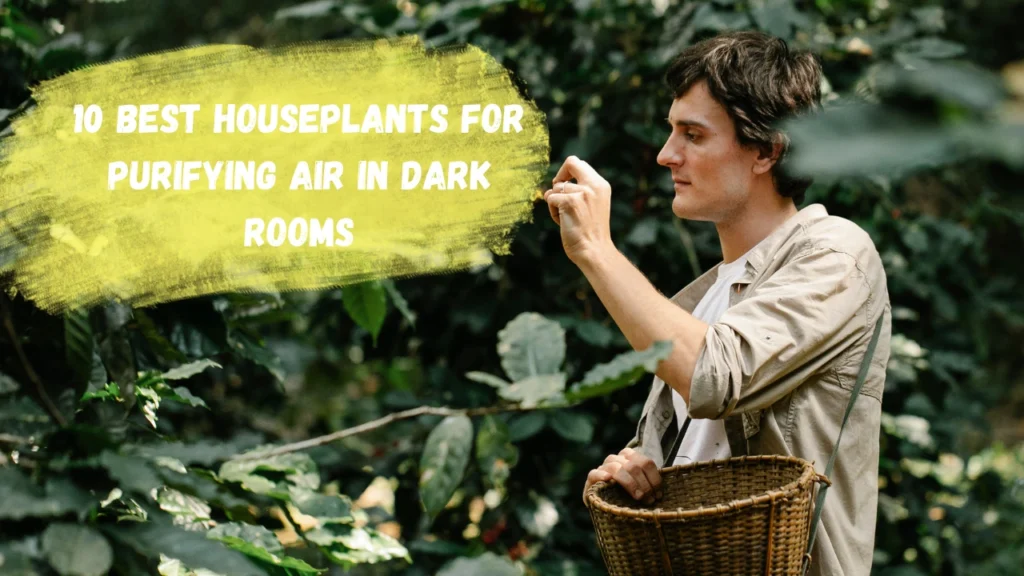10 Best Houseplants for Purifying Air in Dark Rooms

Many houseplants are known for their ability to purify the air by removing toxins and improving humidity levels. If you live in an environment with limited natural light, don’t worry. Here are several lowlighting-tolerant plant species, some of which help purify the air around them. Let’s take a closer look at ten lowlighting tolerant houseplants to breathe fresh and make your indoor life colorful and healthy.

1. Snake Plant (Sansevieria)
Snake plant is commonly known as the mother-in-law’s tongue, a tough indoor plant that thrives under most conditions. The snake plant has been proved to be quite efficient in eliminating airborne toxins like formaldehyde, benzene, and carbon dioxide. It also oxygenates the atmosphere at night, making it ideal for bedroom settings.
Care Tips:
Water only when the soil has dried between watering.
Do not waterlogging as it causes root rot.
Keep the plant in shadowy or low-light areas.
.
2. Peace Lily (Spathiphyllum)
Peace lilies are a very attractive plant with glossy green leaves and elegant white blooms. They are known for its purification ability of air from most harmful pollutants like ammonia, benzene, and formaldehyde. Peace lilies also help to add moisture levels indoors, thus ideal for dry places.
Care Tips:
Place in shaded or lowlight areas.
Water when the topsoil feels dry.
3. Pothos (Epipremnum aureum)
Pothos, also called devil’s ivy, is a fast growing vine that is very easy to care for. It is a champion at eliminating indoor air toxins like xylene, benzene, and formaldehyde. Pothos can tolerate low light and is perfect for hanging baskets or climbing structures.
Care Tips:
Prune occasionally to encourage bushy growth.
Place in indirect or lowlight areas for optimal growth.
4. Spider Plant (Chlorophytum comosum)
The spider plant is one of the classic houseplants, known for its ability to purify indoor air by removing carbon monoxide and formaldehyde. Its bright green and white striped leaves add a touch of brightness to any corner, and it’s safe for homes with pets.
Care Tips:
Allow the soil to dry slightly between waterings.
Position in a well drained pot.
Keep in low to medium light conditions.
5. Boston Fern (Nephrolepis exaltata)
Boston ferns are excellent natural humidifiers, making them ideal for combating dryness during the winter months. They are also effective at removing harmful toxins like formaldehyde and xylene.
Care Tips:
Place in indirect light or shaded areas.
Mist the leaves regularly to maintain humidity.
6. Philodendron
Philodendrons are a hardy group that comes in numerous shapes and sizes, though their most popular ones have heart shaped leaves. They can detoxify large portions of the airborne toxins within them and survive without much light.
Care Tips
Water only when the topsoil dries out
Never expose it to the direct sun; it tends to burn the leaves
Wash the leaves on occasion
7. Areca Palm (Dypsis lutescens)
The Areca palm is a graceful plant that adds a tropical vibe to your indoor space. It’s an excellent air purifier and humidifier, known for filtering toxins like benzene and formaldehyde.
Care Tips:
Keep in low to moderate light.
Water consistently but avoid waterlogging.
Trim yellowing leaves to maintain its lush appearance.
8. Rubber Plant (Ficus elastica)
Rubber plants are low maintenance and highly effective at removing toxins like formaldehyde from the air.
Care Tips:
Place in indirect or lowlight areas.
Water when the topsoil dries out.
Wipe the leaves occasionally to remove dust and enhance their shine.
9. Dracaena
These include Dracaena marginata and Dracaena fragrans, both of which are some of the best air purifying plants. They eliminate harmful toxins such as xylene and benzene while tolerating low light conditions.
Care Tips
Do not place it in direct sunlight.
Turn the plant every so often for it to grow uniformly.
10. ZZ Plant (Zamioculcas zamiifolia)
The ZZ plant is almost indestructible, so it is perfect for busy people or beginners. It is very efficient at purifying indoor air and tolerates low light very well.
Care Tips:
Water sparingly as it stores moisture in its rhizomes.
Place in low to moderate light areas.
Do not overwater to prevent root rot.
Benefits of LowLight Houseplants
1. Improved Air Quality
Lowlight houseplants absorb carbon dioxide and release oxygen, in addition to removing harmful pollutants such as benzene, formaldehyde, and xylene.
2. Reduced Stress and Anxiety
Indoor plants have been known to reduce stress levels and improve mood. They create a peaceful and calm atmosphere.
3. Increased Productivity
They increase concentration and productivity, thus considering them as integral parts of home offices.
4. Humidity Control
Most of the plants in this category release moisture into the air and therefore regulate the amount of air-held moisture within an office-thus supporting optimal humidity levels indoors, which really benefits homes in dry climates or during winter.
5. Low Maintenance
These plants are perfect for individuals with busy lifestyles or limited gardening experience, as they require minimal care and thrive in lowlight conditions.
Arranging and Displaying LowLight Houseplants
1. Hanging Planters: Pothos and spider plants look stunning in hanging baskets, allowing their foliage to cascade elegantly.
2. Corner Accents: Place larger plants like rubber plants or Areca palms in corners to fill empty spaces with greenery.
3. Shelving Displays: Place smaller plants such as snake plants and peace lilies on shelves to make a great display.
4. Terrariums: Create a mini indoor garden by grouping plants like philodendrons and ferns in a glass terrarium.
These ten houseplants are perfect for anyone who wants to purify the air in a room with little natural light. They not only purify the air but also add a warm ambiance to your home or office. By adding these lowlight champions to your living spaces, you can enjoy a healthier, greener, and more inviting environment.